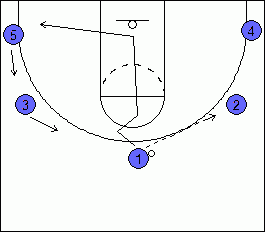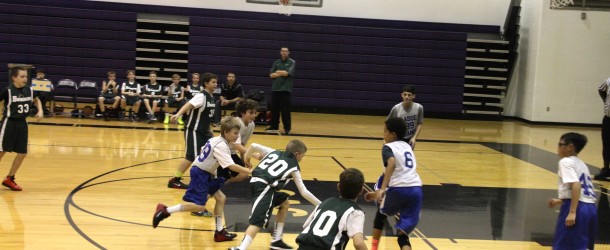One of the offenses many of our Bombers Basketball teams will be using is the 5-out motion.
|
 |
- Rule 3 – Cut Only When You Pass The Ball or when the player with the ball is looking at you.
- Rule 4 – The ball should only be dribbled to improve floor balance or beat the player.
- Rule 5 – Avoid passing to the corner & keep the ball above the free throw line extended.
Teaching Points To Better Execute The Offense:
These are some things that you will want to teach your players along the way. Be careful on teaching these points all at once. Otherwise, it can overwhelm them.
- All cuts are finished at the rim.
- Passer must watch the cutter all the way though. This helps with timing for the next player filling the vacant spot.
- When replacing the cutter, wait until the player with the ball is about done looking at the cutter. This will help with timing and setting up the defender for a back cut or straight cut.
- Back cut when the defender is near 3-point line. Some coaches like to say on the 3-point line, 1 step from the 3-point line, or 1 foot from the 3-point line. It’s up to you to decide what works best for you.
- Always have the ball in triple threat and be ready to dribble penetrate. This offense can sometimes lull the defense to sleep which gives the ball handler opportunities to attack the basket.
Example of an Offensive Sequence
Remember, to execute this offense all you need to know are the 5 rules above. Those rules explain what to do in virtually every situtation. With that said, there are little teaching points that make this offense more effective. Below you’ll find a sample sequence to help you see how everything fits together. As you go through the sequeunce, you’ll notice that the 5 rules are always followed.
| 5 Out Set.Very important to keep spacing for dribble penetration and cutters.2 & 3 should be near the free throw line extended.
4 & 5 should be in the corners. |
 |
| 1 passes the ball to 2 on the wing.After the pass, 1 basket cuts straight to the rim. Then, fills the spot in the opposite corner.3 fills the spot on the top of the key.
5 fills the wing. |
 |
| The defender guarding 3 pressures the pass and steps to the 3-point line.3 back cuts. 2 looks to pass the ball if 3 is open.3 fills the open spot along the baseline.
5 fills the top of the key. 1 fills the wing. |
 |
| 2 passes the ball to 5.2 basket cuts and replaces open spot along baseline.4 fills the spot. |  |
| The pass is not open, so 4 back cuts. |  |
| After 4 cleared the lane, 5 looks to the opposite wing at 1.1 basket cuts3 replaces. |  |
| 5 passes to 3.5 basket cuts.2 & 4 fill the open spots.
Remember, 2 & 4 should not replace as soon as 5 basket cuts. They want to pause until 5 has almost reached the basket to ensure proper timing. |
 |
| 5 clears the lane.3 dribble penetrates.Penetration is cut off. 3 kicks it out to 1 in the corner. |  |
| 1 dribbles towards the wing to create floor balance.As 1 dribbles to the wing, 2 back cuts.1 passes to 2 for a lay up. |  |
Other Situations:
| Pass To CornerDefender packs down near the lane in the corner to help on penetration and basket cuts.If the player in the corner is a slasher or scorer, you can pass him the ball and allow him to shoot or attack. |  |
| Prevent 5 second call2 passes the ball to the corner to avoid the 5 second call and basket cuts. |  |
| 5 immediately dribbles to the wing and looks to the top of the key to start the offense again. |  |
| What To Do With A Good Post PlayerIf you have a good post player, you can give them permission to sit in the post for 2 seconds to try to get position.1 passes to 2. 1 basket cuts.
1 cuts over to the post area to hold the position for 2 seconds. 3 hesitates to fill the spot until the post starts to clear. If 3 leaves too early, it can throw off the timing. |
 |









